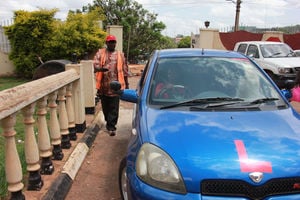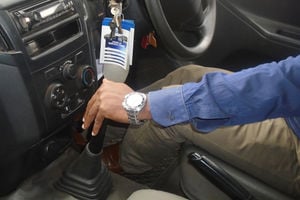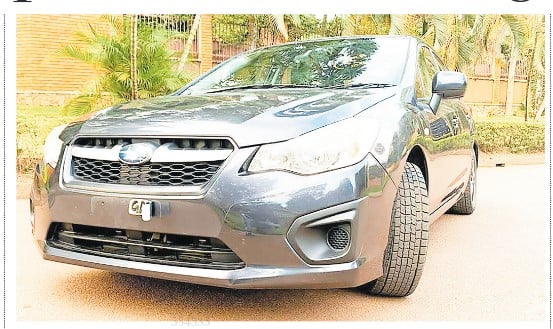
Despite being diligently trained, the first time on the road can be pretty nerve-wrecking. PHOTO BY RACHEL MABALA
Driving is a skill that like any other, is taught and learnt. While no one is born with the ability to drive, with practice and proper instruction, anyone can become a confident and competent driver.
Experts at the Driver and Vehicle Standards Agency (DVSA) suggest that on average, it takes about 45 hours of lessons and 20 hours of practice to learn how to drive. However, this is not a one-size-fits-all estimate. Some people may need more time, while others can learn by observing and practicing what they see.
This is where driving schools play a crucial role. According to the motor vehicle inspection section at the Ministry of Works and Transport, there are 90 fully licensed driving schools in Uganda.
One of the long-established schools is Sulaiman Driving School in Jinja City, which has been operating since the early 1990s. Umalu Luyinda, an instructor at Sulaiman, believes that while there is no fixed timeframe for learning, a structured approach can make a big difference.
“At least one month,” he recommends, when asked about the optimal duration for learning. “We begin with two weeks of theory, focusing on traffic laws, car basics, and defensive driving. After that, practical sessions start in a controlled space before moving onto the road. After six weeks, learners should feel confident enough to drive alongside other road users.”
He stresses the importance of mastering the fundamentals; foot placement on pedals, proper seating posture, mirror usage, and recognising road signs. These are the building blocks of safe driving, alongside other essential skills such as parking, turning, and handling blind spots.
Learning the hard way
While many learners grasp these concepts with ease, some underestimate the complexity of driving. Brian Omona, a court clerk, thought he was ready after a few short lessons. However, three weeks later, he was involved in a minor accident when he failed to check his side mirror before making a turn, bumping into a motorcyclist.
“I indicated and turned, but I did not use my mirror. I could have avoided the accident if I had checked,” Omona recalls. Luyinda emphasises that mirror usage is a crucial habit for all drivers, and thorough instruction could have prevented Omona’s mistake.
Health and psychological barriers
For some, learning to drive goes beyond mastering technical skills. Jonathan Bisaso experienced amaxophobia, a fear of driving that made him give up entirely.
“I would get extremely anxious every time a car came close to mine. No matter how much my instructor encouraged me, I could not shake the feeling that I would crash,” Bisaso shares. While amaxophobia can be managed with professional help, it highlights that learning to drive involves overcoming both mental and physical barriers.
Beyond phobias, other challenges that prevent people from learning to drive include visual impairments, disabilities, financial limitations, and mental health issues. Some choose not to learn because they rely on alternative transport methods, while others avoid driving school due to the perceived high costs.
The importance of professional training
Asiimwe Dembe, managing director at Dembe Driving School in Kampala, notes that many Ugandans opt to learn from friends or family instead of enrolling in professional driving schools.
“This leads to many unskilled drivers on the road,” he explains. Asiimwe believes that a comprehensive driving course should include 30 hours of practice and 28 hours of theory to properly equip learners. He cautions against shortcuts.
“Driving is a skill that improves with time. The more you practice under proper supervision, the better you become. Those who learn informally often lack crucial skills,” Asiimwe warns.
When to learn
While there is no set age to begin driving lessons, Asiimwe advises starting early, ideally around age 20.
“The younger, the better. Older learners, particularly those over 60, tend to struggle more with reaction time and decision-making,” he notes. Since driving requires quick thinking and decisive action, older learners may find it harder to pick up the skill.
Driving schools: More than just licenses
Asiimwe stresses that driving schools are not just a means to acquire a license. They offer a structured environment that prioritises safety and helps learners develop comprehensive driving skills.
“Learning from a friend or relative might teach you how to operate a vehicle, but driving schools focus on safe and responsible driving,” he adds.
The bigger picture: road safety
Uganda Police Force statistics show that out of 9,679 traffic offenders arrested, 1,709 were for reckless driving, 837 had invalid licenses, and 446 were caught speeding. Many of these offenses stem from human error, which could be mitigated by proper training in driving schools.
Despite the challenges some face in learning to drive, Asiimwe remains optimistic.
“No one should be discouraged from learning to drive. With the right approach, anyone can become a safe and competent driver,” he says.
SET GOALS
According to myfirst. com, you will no doubt be familiar with your driving instructor asking you what you would like to achieve from each driving lesson. Make sure you take some time to think about your goals and how your instructor can help you. Many instructors use a reflective log; the aim is that after each lesson you reflect on what went well, and what you would like to improve on next time. Before each lesson, check your reflective log and ask yourself: 1. What would you like to practise in your next lesson? 2. What will an improvement look like/feel like? 3. How will you know you’ve achieved this goal? 4. What can you do before your lesson to prepare? 5. What do you need to know from your instructor that might help?








